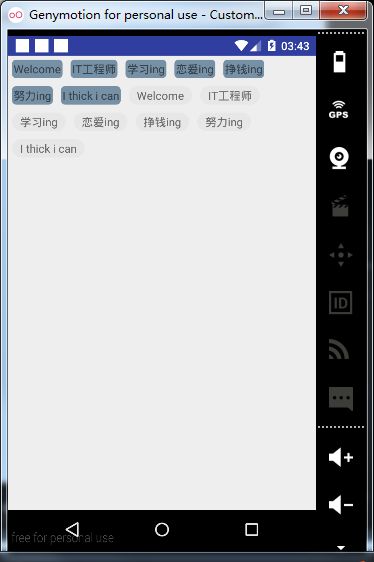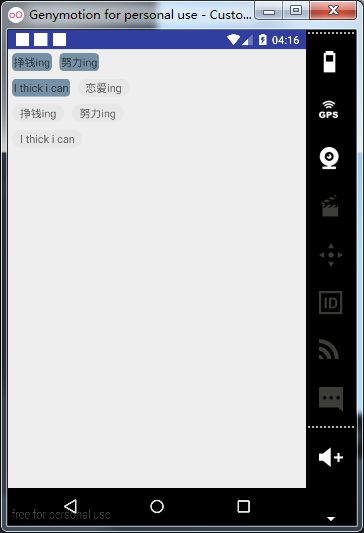最近一直在学习自定义View和自定义ViewGroup的东西,今天没事干就研究了一下FlowLayout,记录下实现步骤,参考自鸿洋博客
AndroidStudio使用
在根projcet的build.gradle中添加.
maven { url 'https://jitpack.io' }
在项目的build.gradle添加:
compile 'com.github.superSp:FlowLayout:1.0'
github有源码查看
效果图 自适应
效果图 固定大小
使用方法——静态添加
style文件:
drawable文件:
样式1(flag_01)
样式2(flag_02)
按自己喜好设置就行~~
使用方法——动态添加
FlowLayout flowLayout = new FlowLayout(this);
flowLayout.initData(Arrays.asList("Welcome","IT工程师","学习ing","恋爱ing"
,"挣钱ing","努力ing","I thick i can"));
setContentView(flowLayout);
initData方法
public void initData(List list)
public void initData(List list, int margin, int drawable)
添加点击事件
flowLayout.setOnTabClickListener(new FlowLayout.IOnTabClickListener() {
@Override
public void onTabClick(int position, TextView textView) {
Toast.makeText(Test.this,position+" "+textView.getText(),Toast.LENGTH_SHORT).show();
}
});
setContentView(flowLayout);
实现思路
构造方法
public FlowLayout(Context context) {
this(context, null);
}
public FlowLayout(Context context, AttributeSet attrs) {
this(context, attrs, 0);
}
public FlowLayout(Context context, AttributeSet attrs, int defStyleAttr) {
super(context, attrs, defStyleAttr);
}
子view支持margin属性
@Override
public LayoutParams generateLayoutParams(AttributeSet attrs) {
return new MarginLayoutParams(getContext(), attrs);
}
onMeasure方法
@Override
protected void onMeasure(int widthMeasureSpec, int heightMeasureSpec) {
super.onMeasure(widthMeasureSpec, heightMeasureSpec);
int widthSize = MeasureSpec.getSize(widthMeasureSpec);
int heightSize = MeasureSpec.getSize(heightMeasureSpec);
int widthMode = MeasureSpec.getMode(widthMeasureSpec);
int heightMode = MeasureSpec.getMode(heightMeasureSpec);
//测量子view的大小
measureChildren(widthMeasureSpec, heightMeasureSpec);
//最终的宽和高
int width = 0;
int height = 0;
//记录每一行的宽和高
int lineWidth = 0;
//子view数量
int cCount = getChildCount();
View cView;
MarginLayoutParams params;
int cWidth, cHeight;
for (int i = 0; i < cCount; i++) {
cView = getChildAt(i);
params = (MarginLayoutParams) cView.getLayoutParams();
cWidth = cView.getMeasuredWidth() + params.leftMargin + params.rightMargin;
cHeight = cView.getMeasuredHeight() + params.topMargin + params.bottomMargin;
ViewBean viewBean = new ViewBean();
if (lineWidth + cWidth < widthSize) {
lineWidth += cWidth;
height = Math.max(height, cHeight);
width = Math.max(lineWidth, width);
} else {
width = Math.max(lineWidth, width);
height += cHeight;
lineWidth = cWidth;
}
viewBean.setLeft(lineWidth - cWidth + params.leftMargin);
viewBean.setTop(height - cHeight + params.topMargin);
viewBean.setRight(lineWidth - params.rightMargin);
viewBean.setBottom(height - params.bottomMargin);
list.add(viewBean);
}
setMeasuredDimension(widthMode == MeasureSpec.EXACTLY ? widthSize : width, heightMode == MeasureSpec.EXACTLY ? heightSize : height);
}
onLayout方法
@Override
protected void onLayout(boolean changed, int l, int t, int r, int b) {
int cCount = getChildCount();
for (int i = 0; i < cCount; i++) {
getChildAt(i).layout(list.get(i).getLeft(), list.get(i).getTop(), list.get(i).getRight(), list.get(i).getBottom());
}
}
ViewBean方法
private class ViewBean {
private int left;
private int right;
private int top;
private int bottom;
public int getLeft() {
return left;
}
public void setLeft(int left) {
this.left = left;
}
public int getRight() {
return right;
}
public void setRight(int right) {
this.right = right;
}
public int getTop() {
return top;
}
public void setTop(int top) {
this.top = top;
}
public int getBottom() {
return bottom;
}
public void setBottom(int bottom) {
this.bottom = bottom;
}
}
动态填充数据实现
public void initData(List list) {
ViewGroup.MarginLayoutParams pa = new ViewGroup.MarginLayoutParams(ViewGroup.MarginLayoutParams.WRAP_CONTENT,
ViewGroup.MarginLayoutParams.WRAP_CONTENT);
int size = list.size();
for (int i = 0; i < size; i++) {
TextView tv = new TextView(getContext());
tv.setText(list.get(i));
addView(tv, pa);
((ViewGroup.MarginLayoutParams) tv.getLayoutParams()).setMargins(DensityUtils.dp2px(getContext(), 5), DensityUtils.dp2px(getContext(), 5),
DensityUtils.dp2px(getContext(), 5), DensityUtils.dp2px(getContext(), 5));
tv.setBackgroundResource(R.drawable.flag_01);
}
}
添加点击事件
public interface IOnTabClickListener {
void onTabClick(int position, TextView textView);
}
private void setOnclick(final int position, final TextView textView) {
textView.setOnClickListener(new OnClickListener() {
@Override
public void onClick(View view) {
iOnTabClickListener.onTabClick(position, textView);
}
});
}
后记
比较难理解的部分应该就是onMeasure了。。当设置wrap的时候找到宽度最大的值。。并且设置每个view的坐标.

